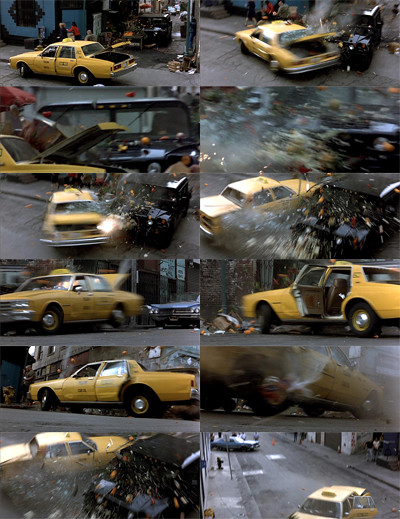The Rock, 1996, directed by Michael Bay, screenplay by David Weisberg & Douglas S. Cook and Mark Rosner, story by David Weisberg & Douglas S. Cook.
Here's Michael Bay on the commentary track for The Rock, talking about his decision to insert a stand-alone car chase into the film, a sequence that, for all its sound and fury, accomplishes exactly nothing that has anything at all to do with the narrative.
Actually, I had a fight about the car chase with one of the writers, because I felt, "This is a way for me to help, after all this complicated setup, to help suck the younger audience back into it." And I know that sounds kind of weird, of trying to make movies for demographics and whatnot but, basically that's, that's what it was. I had a fight with one of the writers, um, he said "I've never heard of a director talking about demographics." And I'm like, "Well,"—this is a writer who's never had a script actually made into a movie—and I said, "Well, let me tell you something. If you're given 60 million dollars, you'd better fucking know who you're selling this movie to, because it could be the last time they ever give you 60 million dollars again." We're in a business, and this was, my idea with The Rock was to take people on a big ride and have fun characters in the movie. This is like an e-ticket ride, kind of, one-third into the movie, and, you know? I think it did the trick around the world—it's so far made 340 million dollars.
And here's Michael Bay explaining how he knew the movie needed a car chase at this particular point:
That was something on the first test screening that worked beautifully, because what I do as a director is I watch their body movements. When they start to fidget, when they start to look at their watch, you know you've got a problem with your film. When they start to jump up to the bathroom a lot, you know that there's a problem in the movie right about there. when, just when generally a lot of people go to the bathroom at a certain point in the movie.
And here's Michael Bay, blowing a cable car halfway into outer space to stop bored teenagers from taking a piss:
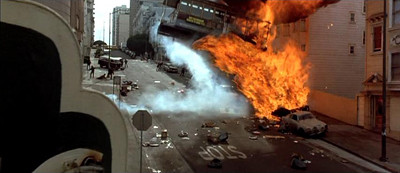
And there in a nutshell, is everything people hate about Michael Bay. He reduces film to a pure business transaction, he believes you can't possibly underestimate the attention spans of "the younger audience," and he's utterly contemptuous of not only the screenwriters he works with but with story itself. It's easy to see why he's anathema to critics, and equally easy to see why studio executives love the guy. I went into more detail about this when writing about Armageddon, but the key thing about Michael Bay movies is that they are not designed to tell stories. The narrative elements in The Rock, character, plot, dialogue, are there as signals in a sort of cinematic aggressive mimicry. He's making amusement park rides that look like movies.
So, as with Armageddon, you can make a staggeringly long list of ways in which The Rock fails as a narrative. And it's fun to do! The characters talk like movie posters (actual line: "Mason's angry. He's lethal. He's a trained killer. And he is the only hope that we have got.") Stereotypes pop up like clockwork when Bay wants a laugh, from the gay hairdresser to (really!) an angry Asian chef hollering at Sean Connery for invading his kitchen.
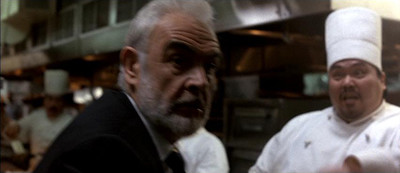
Although Bay hadn't yet graduated to Armageddon's world without time zones, the film's geography is muddled enough that an apartment in Washington D.C. has a view of the Library Tower.
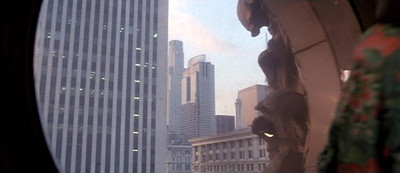
For some reason1 there's a system of mine carts deep below Alcatraz island, with both traditional tracks and a suspended monorail.

And of course, in the film's most celebrated line, we're asked to believe that a Scotsman who has been in prison since the 1960s would have a personal philosophy built around the concept of "prom." But look: this is like writing a list of ways in which the Judas Breed fails to resemble a human being. It's too easy, and it's kind of beside the point. Mimicry doesn't have to work over the long term, it just has to get the predator close enough to eat you—or take your 340 million dollars.
The baffling thing about The Rock, as Jeanine Basinger points out, is how many critics admired it while scorning Armageddon. Roger Ebert, for example, called The Rock "a first-rate, slam-bang action thriller with a lot of style and no little humor," while Armageddon was "an assault on the eyes, the ears, the brain, common sense and the human desire to be entertained." And yet in nearly every particular, the form and content of the two films are identical.2 They're both positively dripping with what Matt Zoller Seitz, in the best examinatipn of Bay's aesthetic I've read, called a "distinctively American hybrid of latent fascism and ingrained consumerism." So what's the reason for their different reception? I think it basically comes down to two things. The first is nostalgia for Sean Connery's version of James Bond, which is a much stronger force than, say, nostalgia for Bruce Willis's character on "Moonlighting." The second is Nicolas Cage's pathological inability to phone in a performance. Whether he's in an amazing movie or a terrible one, Cage commits with scary-eyed intensity to whatever bullshit he's selling.

He can't save every movie from its own ridiculousness, but he does a lot for The Rock. I could go into more detail about precisely what bullshit Cage is selling here, but I'm going to assume for both our sakes that you either know the premise of The Rock or have no interest in ever knowing it.
So let's take it as a given that Michael Bay isn't particularly interested in plot or character, and talk about the things that do interest him. In The Rock, there are basically two things that Michael Bay lingers on: scenes in which characters make tough, principled decisions, and action sequences. For all the attention paid to Michael Bay's action sequences, it's in his "tough call" scenes that he has an immediately recognizable style. Here's the platonic ideal of a Michael Bay shot: Ed Harris, as General Francis Hummel, in a close-up favoring his chin.
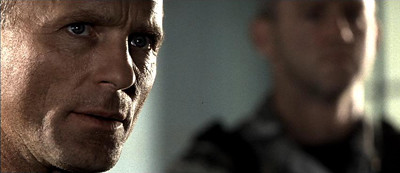
Hummel's the leader of a gang of mutineers threatening to launch a nerve gas attack against San Francisco.3 The image is from a scene in which Hummel calls off the attack and military discipline breaks down. In about two minutes, I counted no fewer than five shots in which Bay slowly tracks in on one of his actors' chins. That's against four master shots, two of which are point-of-view shots from characters surreptitiously observing the scene (which is to say, they're serving a different narrative purpose that precludes close-ups). Conversations are all-close-up, all the time, and that, as much as the swells in Hans Zimmer's score, convinces us we are seeing big moments. Bay takes this idea to its logical conclusion: I guarantee you have never seen anyone fumble for the right key on a key ring in such a dramatic fashion.

To be fair, Bay doesn't always track in on the chin of a character making a tough decision. When the President decides to drop thermite on Alcatraz Island and kill all the hostages, he goes to voiceover over shots of American military might that would be too fetishistic for Air Force recruiting commercials:
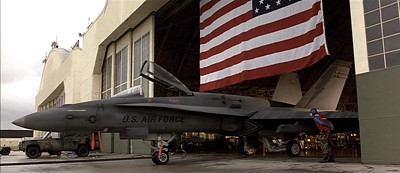
But that's Bay's basic technique for scenes with dialogue. The slow tracking shots and close-ups produce a conditioned response: we must be seeing a moment of supreme dramatic importance. After all, why else would the camera get in so close? Why else is the music swelling?
The action sequences are less distinctive, but again, there are a series of techniques Bay returns to again and again. First, he gets the camera as close as he possibly can. In the gunfights in The Rock, you will very rarely see the person firing the gun and their target in the same frame, even when they're shooting at point-blank range. There's also plenty of the kind of run-and-gun handheld that David Bordwell has critiqued in the Bourne films. There are aesthetic pluses and minuses to run-and-gun, but in studying The Rock I noticed a clear practical advantage: your stars don't have to do stunts. In the entire car chase sequence, there are three shots of Nicolas Cage or Sean Connery behind the wheel of a moving car. Connery actually drives the car away from the valet station:
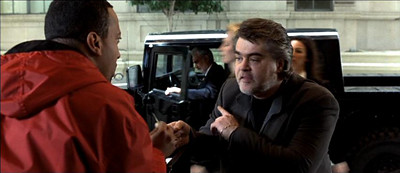
And roughly halfway through, there are matching shots from the passenger seat of Connery and Cage driving:

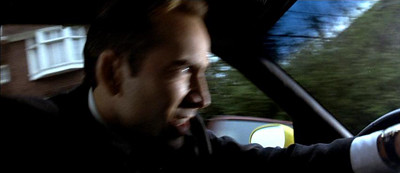
The rest of the chase is entirely done with close-ups, shot through the windshield while PAs bounce the car up and down.

Steve McQueen might not have done as much driving in Bullit as he claimed, but he did more than that.
Amid all the extreme close-ups and Queasicam, Michael Bay occasionally shoots from a distance, using tripods, wide shots, cranes, and other elegant weapons for a more civilized age. Once or twice per action sequence, we get a stunt that is impressive (or expensive) enough that a handheld camera won't do it justice. So how do you blend more traditional shots with run-and-gun? Basically, by stutter-cut editing the shit out of it. Take a single stunt from the car crash sequence: Connery's character plows his Humvee into a parked taxi, sending it flying. In real life, this crash probably took about one second; on film, it takes just over three. Here's the first and last frame of each cut in the sequence (click the image for a higher resolution).
In those three seconds, Bay uses six different shots from four different cameras (shots 1, 3, and 6 are from the same crane shot). With each edit, he skips backwards in time, showing the moment of impact again and again and again.4 Well, it blends in fine with the rest of the car chase.
Master the slow track, the close up, the Queasicam, and the stutter cut, and you will just about have Michael Bay's filmmaking technique down cold. In The Rock, he didn't have quite the talent for perfectly composed Super Bowl commercial images that he developed by the time he shot Armageddon, but the rest of it's all there. None of his stylistic tics are particularly hard to duplicate, and most of them are pretty effective, if used sparingly. Maybe some day an enterprising young director will use them to tell a story.
Which brings us, once again, to Michael Bay in his own words: "What I do as a director is I watch their [test screening audiences'] body movements." That's not directing so much as it is straightforward stimulus-response. Bay is, I think, the leading figure of a school of filmmaking we might call the Pavlovians, cashing in on responses conditioned by other, better movies. Take away the food, and the dog keeps drooling.
Randoms
- Cage and Connery may not have done much driving, but indisputably performed one stunt their insurance companies must not have known about: having two stunt men hold them underwater while flames roared overhead. Connery wasn't thrilled about it; Entertainment Weekly has him yelling "So you're telling me I could burn my face off!" at Bay. (Nicolas Cage was eavesdropping).
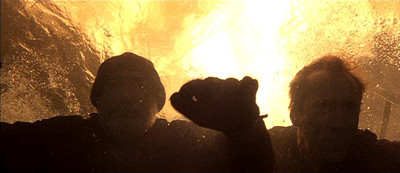
- The screenwriter Bay got into an argument with about the car chase was almost certainly Mark Rosner, who was fired over the car chase. The same EW article that has Connery yelling about the fireballs has Rosner describing their clashes over the script like this:
I would say I wrote a man's movie, and Michael always had it in his head to make a boy's movie. And I think he found people to provide him with the appropriately juvenile material.
1I like to think the rough outline for a Michael Bay film is a long list of bullet points, each of which begins with the phrase "For some reason..."
2Basinger thinks this means critics should have embraced both films. That's one way to look at it.
3Somewhat bizarrely, Hummel's motive is to draw attention to the unacknowledged deaths of special forces units during Desert Storm. Apparently he couldn't get Dana Priest or Ann Hull on the phone.
4This is what separates your top-tier Michael Bay parodies from the lesser efforts, because to ape this technique, you need multiple cameras.
